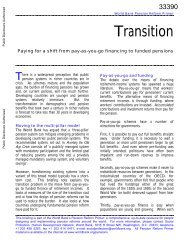Financial Sector Development in Africa: Opportunities ... - World Bank
Financial Sector Development in Africa: Opportunities ... - World Bank
Financial Sector Development in Africa: Opportunities ... - World Bank
Create successful ePaper yourself
Turn your PDF publications into a flip-book with our unique Google optimized e-Paper software.
120 Walley<br />
and 2.5 million <strong>in</strong> cities. The balance of urban to rural need varies from<br />
country to country, with many less-urbanized countries see<strong>in</strong>g the primary<br />
need <strong>in</strong> rural areas. The proportion of urban to rural need has<br />
important policy implications of how to f<strong>in</strong>ance the hous<strong>in</strong>g gap. For<br />
example, <strong>in</strong> Nigeria, which is fast urbaniz<strong>in</strong>g, 550,000 houses are needed<br />
<strong>in</strong> cities and just 144,000 <strong>in</strong> villages. Contrast this with the situation <strong>in</strong><br />
Kenya, which requires just 65,000 urban dwell<strong>in</strong>gs but 136,000 rural<br />
dwell<strong>in</strong>gs on an annual basis. As the figure shows, this balance for <strong>Africa</strong><br />
as a whole is gradually shift<strong>in</strong>g, so that by 2050 almost the entire hous<strong>in</strong>g<br />
need will be <strong>in</strong> urban areas.<br />
Alongside this analysis, it should also be remembered that most<br />
<strong>Africa</strong>n countries are not start<strong>in</strong>g <strong>in</strong> a position where all hous<strong>in</strong>g needs<br />
are met. Hous<strong>in</strong>g shortages already exist, and meet<strong>in</strong>g only the forecast<br />
hous<strong>in</strong>g needs would preserve the status quo. Hous<strong>in</strong>g production needs<br />
to go beyond this if the pre-exist<strong>in</strong>g hous<strong>in</strong>g gaps are to be closed. These<br />
exist<strong>in</strong>g gaps are very difficult to quantify, however. Estimates often vary<br />
by several million with<strong>in</strong> the same country, depend<strong>in</strong>g on the source of<br />
the data. The gaps also tend to reflect a qualitative shortage <strong>in</strong> hous<strong>in</strong>g<br />
rather than an absolute lack of shelter. The number of truly homeless<br />
households will be small, but those liv<strong>in</strong>g <strong>in</strong> overcrowded or unsanitary<br />
conditions will be much higher.<br />
The forecasts <strong>in</strong> the hous<strong>in</strong>g need analysis are from the United Nations<br />
and do presuppose a grow<strong>in</strong>g level of urbanization. The world as a whole<br />
now lives predom<strong>in</strong>antly <strong>in</strong> cities, with the 50 percent urbanization mark<br />
passed <strong>in</strong> 2009. However, <strong>Africa</strong> rema<strong>in</strong>s largely rural. The extent of<br />
urbanization does vary across the cont<strong>in</strong>ent by country. Nigeria, for<br />
example, has eight cities with over 1 million <strong>in</strong>habitants and one of the<br />
largest urban metropolises <strong>in</strong> the world, Lagos. In contrast, some countries<br />
with large populations, such as Ethiopia, have four out of five <strong>in</strong>habitants<br />
still liv<strong>in</strong>g <strong>in</strong> rural areas. Sub-Saharan <strong>Africa</strong>, which now accounts<br />
for 12 percent of the world’s population, will account for more than a<br />
third of the global population by 2100 by many projections.<br />
The debate about urbanization is a complex one, and it meets a lot of<br />
resistance <strong>in</strong> <strong>Africa</strong>n policy circles. Urbanization is often perceived as a<br />
threat to a traditional way of life. The important po<strong>in</strong>t to realize is that<br />
sett<strong>in</strong>g deliberate policy to slow the urbanization process has rarely succeeded<br />
and ignor<strong>in</strong>g it completely is likely to result <strong>in</strong> unplanned cities.<br />
Once <strong>in</strong>formal settlements appear, it is difficult to then reorganize a city<br />
<strong>in</strong> l<strong>in</strong>e with a central urban plan. The data <strong>in</strong> this report give a clear <strong>in</strong>dication<br />
of what is likely to happen <strong>in</strong> the com<strong>in</strong>g years. Plann<strong>in</strong>g the







